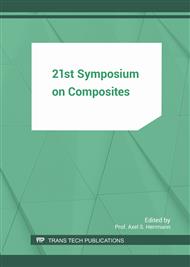[1]
H.M. Inglis, P.H. Geubelle, K. Matouš, H. Tan, and Y. Huang. Cohesive modeling of dewetting in particulate composites: micromechanics vs. multiscale finite element analysis. Mechanics of Materials, 39(6): 580-595, (2007).
DOI: 10.1016/j.mechmat.2006.08.008
Google Scholar
[2]
Ted Belytschko, Stefan Loehnert, and Jeong-Hoon Song. Multiscale aggregating discontinuities: A method for circumventing loss of material stability. International Journal for Numerical Methods in Engineering, 73(6): 869-894, (2008).
DOI: 10.1002/nme.2156
Google Scholar
[3]
E.W.C. Coenen, V.G. Kouznetsova, and M.G.D. Geers. Novel boundary conditions for strain localization analyses in microstructural volume elements. International Journal for Numerical Methods in Engineering, 90(1): 1-21, (2012).
DOI: 10.1002/nme.3298
Google Scholar
[4]
M. Kästner, M. Obst, J. Brummund, K. Thielsch, and V. Ulbricht. Inelastic material behavior of polymers - experimental characterization, formulation and implementation of a material model. Mechanics of Materials, 52(0): 40-57, (2012).
DOI: 10.1016/j.mechmat.2012.04.011
Google Scholar
[5]
I. Emri and N. W. Tschoegl. Generating line spectra from experimental responses. part i: Relaxation modulus and creep compliance. Rheologica Acta, 32(3): 311-321, (1993).
DOI: 10.1007/bf00434195
Google Scholar
[6]
S. Zhandarov and E. Mäder. Characterization of fiber/matrix interface strength: applicability of different tests, approaches and parameters. Composites Science and Technology, 65(1): 149-160, (2005).
DOI: 10.1016/j.compscitech.2004.07.003
Google Scholar
[7]
John A Nairn. Analytical fracture mechanics analysis of the pull-out test including the effects of friction and thermal stresses. Advanced Composites Letters, 9(6): 373-383, (2000).
DOI: 10.1177/096369350000900601
Google Scholar
[8]
S. Zhandarov, E. Pisanova, and E. Mäder. Is there any contradiction between the stress and energy failure criteria in micromechanical tests? part ii. crack propagation: Effect of friction on force-displacement curves. Composite Interfaces, 7(3): 149-175, (2000).
DOI: 10.1163/156855400300185289
Google Scholar
[9]
J.H. Tsai, A. Patra, and R. Wetherhold. Finite element simulation of shaped ductile fiber pullout using a mixed cohesive zone/friction interface model. Composites Part A: Applied Science and Manufacturing, 36(6): 827-838, (2005).
DOI: 10.1016/j.compositesa.2004.10.025
Google Scholar
[10]
Yuanyuan Jia, Wenyi Yan, and Hong-Yuan Liu. Carbon fibre pullout under the influence of residual thermal stresses in polymer matrix composites. Computational Materials Science, 62(0): 79 - 86, (2012).
DOI: 10.1016/j.commatsci.2012.05.019
Google Scholar
[11]
CH Marotzke. Influence of the fiber length on the stress transfer from glass and carbon fibers into a thermoplastic matrix in the pull-out test. Composite Interfaces, 1(2): 153-166, (1993).
DOI: 10.1163/156855493x00040
Google Scholar
[12]
H L Cox. The elasticity and strength of paper and other fibrous materials. British Journal of Applied Physics, 3(3): 72, (1952).
Google Scholar
[13]
Xiaoqiang Wang, Jifeng Zhang, Zhenqing Wang, Wenyan Liang, and Limin Zhou. Finite element simulation of the failure process of single fiber composites considering interface properties. Composites Part B: Engineering, 45(1): 573-580, (2013).
DOI: 10.1016/j.compositesb.2012.07.051
Google Scholar
[14]
M. Nishikawa, T. Okabe, and N. Takeda. Determination of interface properties from experiments on the fragmentation process in single-fiber composites. Materials Science and Engineering: A, 480(1-2): 549-557, (2008).
DOI: 10.1016/j.msea.2007.07.067
Google Scholar
[15]
Christian Miehe. Computational micro-to-macro transitions for discretized micro-structures of heterogeneous materials at finite strains based on the minimization of averaged incremental energy. Computer Methods in Applied Mechanics and Engineering, 192(5-6): 559-591, (2003).
DOI: 10.1016/s0045-7825(02)00564-9
Google Scholar
[16]
S. Toro, P.J. Sánchez, A.E. Huespe, S.M. Giusti, P.J. Blanco, and R.A. Feijóo. A two-scale failure model for heterogeneous materials: numerical implementation based on the finite element method. International Journal for Numerical Methods in Engineering, 97(5): 313 351, (2014).
DOI: 10.1002/nme.4576
Google Scholar


